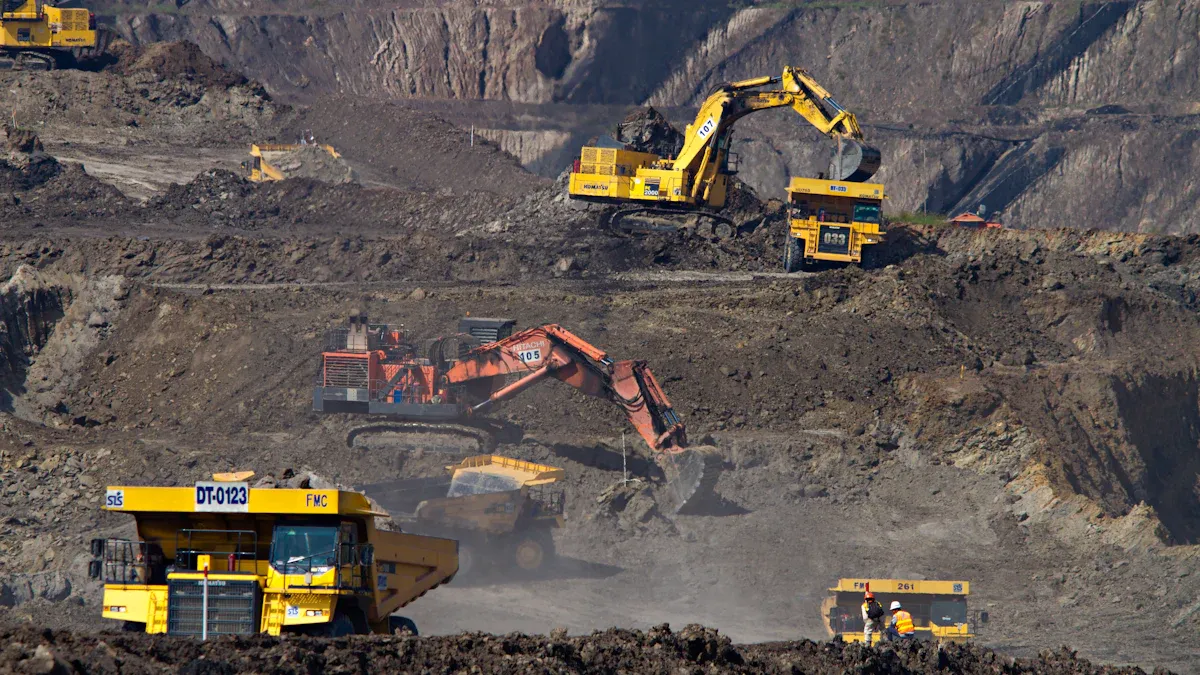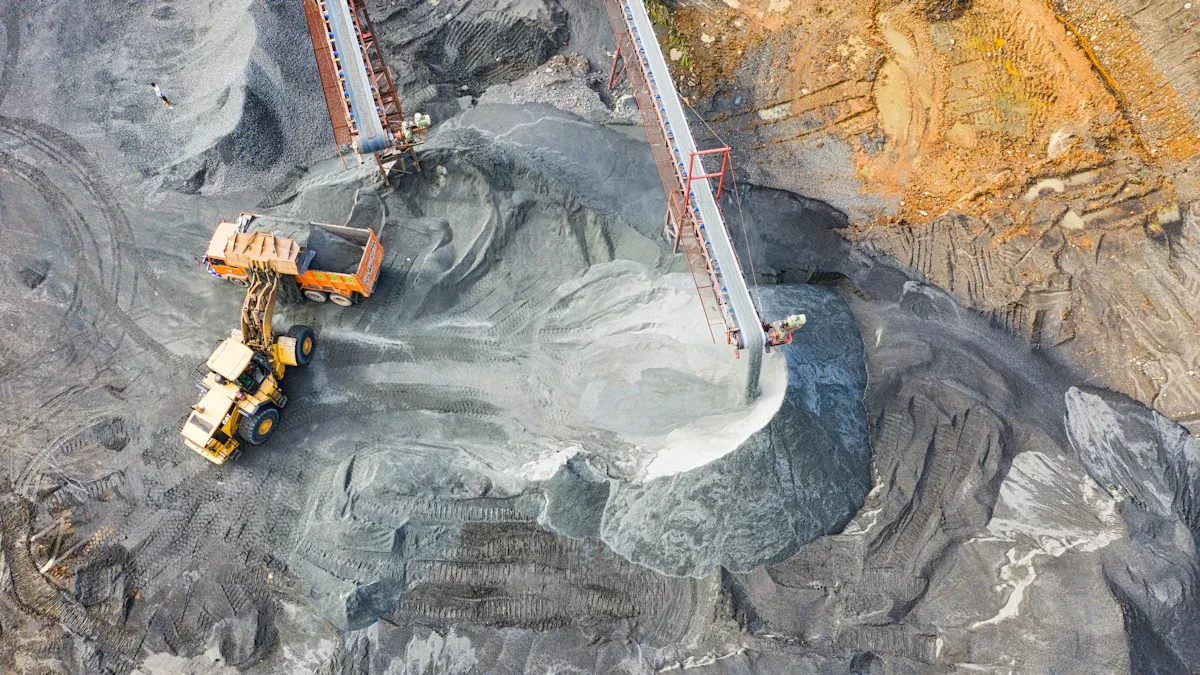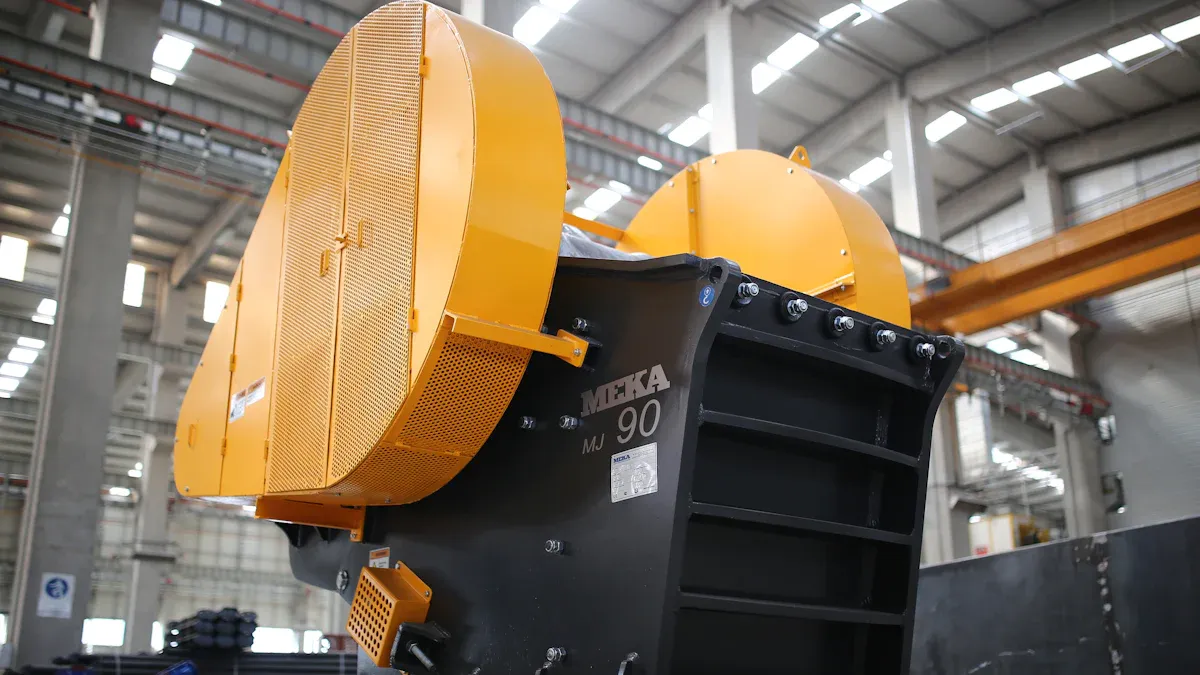
Jaw plate crusher parts are essential components in crushing equipment. These parts play a key role in breaking down large rocks or materials into smaller, more manageable sizes. Their primary function is to grip and crush the material with precision, ensuring reliable operation.
The effectiveness of jaw plate crusher parts directly impacts industrial crushing per
formance. For example:
1. Larger jaw box sizes, such as 20 X 30, deliver higher throughput efficiency (measured in tons per hour or TPH) compared to smaller sizes like 10 X 16.
2. Proper feeding techniques, like choke feeding, maximize production capacity and improve particle shape, highlighting the importance of these components in achieving optimal results.
Without the right jaw plate crusher parts, crushing operations can become inefficient, leading to reduced produ ctivity and uneven material sizes.
Jaw plate crusher parts are t he replaceable components of jaw crushers that perform the critical task of crushing materials. These plates are positioned inside the jaw crusher, with one plate fixed and the other movable. Together, they create a V-shaped chamber where rocks or other materials are compressed and broken down into smaller pieces.
The design and material composition of jaw plates directly influence their performance. Engineers carefully consider factors like stress distribution, deflection, and material properties during the design process. For instance, lighter jaw crushers require precise calculations to ensure the plates can withstand operational stresses without compromising efficiency. The table be low highlights key findings from technical studies on jaw plate design:
| Evidence Description | Key Findings |
|---|---|
| The design of lighter weight jaw crushers requires precise accounting of stresses and deflections in the crushing plates. | This indicates the importance of design optimization in enhancing crusher efficiency. |
| The economy of the crushing process is influenced by the angle of nip and other design parameters. | This highlights the functional importance of jaw plate design in productivity. |
| Structural analysis at the design stage can prevent vibrations and fatigue cracks. | This emphasizes the need for robust design to ensure longevity and performance. |
| The use of computerized programs for quick design can lead to significant weight savings in jaw plates. | This shows advancements in design technology that improve efficiency. |
These findings demonstrate how jaw plate crusher parts are not just simple components but are the result of advanced engineering and design optimization.
Jaw plate crusher parts serve several essential functions in crushing equipment. Their primary role is to apply force to the material being crushed, breaking it into smaller, more manageable sizes. This process involves the interaction of the fixed and movable jaw plates, which work together to create a powerful crushing action.
The efficiency of jaw plates depends on their design and material properties. For example, the angle of nip—the angle between the fixed and movable plates—affects how effectively the material is gripped and crushed. A well-designed angle ensures maximum contact with the material, improving crushing efficiency. Studies have shown that optimizing this angle can significantly enhance productivity and reduce energy consumption.
| Study Title | Key Findings |
|---|---|
| Computer Aided Design and Analysis of Swing Jaw Plate of Jaw Crusher | Analyzed six sets of crushing plates, focusing on performance metrics like crushing energy and force, and assessed the suitabilit y of various plate types. |
| Computer Aided Design and Finite Element Analysis of Swing Jaw Plate of Jaw Crusher | Discussed the importance of accounting for stresses in swing plates and the need for design adjustments based on rock strength. |
| Design and Finite Element Analysis of Swing Jaw Plate of Jaw Crus her with Stiffener | Emphasized the role of material properties and design adjustments to improve productivity and reduce vibrations. |
In addition to crushing, jaw plates also help maintain the structural integrity of the crusher. By absorbing and di stributing the forces generated during operation, they prevent damage to other components. This makes jaw plate crusher parts indispensable for the smooth and efficient functioning of crushing equipment.

Fixed jaw plates are stationary components mounted inside the jaw crusher. These plates form one side of the crushing chamber and provide a stable surface against which the material is compressed. Their primary role is to withstand immense pressure during crushing operations, ensuring the material is broken down efficiently.
You’ll find that fixed jaw plates are often made from high-grade manganese steel. This material offers excellent durability and wear resistance, making it ideal for handling tough ores and abrasive materials. Compared to other crusher parts, fixed jaw plates typically have a longer service life and are better suited for demanding applications.
< td>Service Life
| Feature | Fixed Jaw Plates | O ther Crusher Parts |
|---|---|---|
| Material | High-grade manganese steel | Various materials |
| Durability | Enhanced durability and wear resistance | Generally lower durability |
| Suitability for Tough Ores | Suitable for handling tougher ores | May not handle tough ores effectively |
| Longer service life | Shorter service life |
This table highlights why fixed jaw plates are a critical choice for heavy-duty crushing tasks. Their robust design ensures reliability and reduces the need for frequent replacements.
Movable jaw plates work in tandem with fixed jaw plates to create the crushing action. These plates are attached to a pivoting mechanism, allowing them to move back and forth. As the movable plate presses against the fixed plate, the material i s crushed into smaller pieces.
The design of movable jaw plates focuses on maximizing efficiency. Engineers carefully calculate the angle of movement to ensure optimal force application. This precision helps you achieve consistent crushing results while minimizing energy consumption. Movable jaw plates also require hi gh wear resistance, as they endure constant friction during operation.
Wh en selecting movable jaw plates, consider factors like the type of material being processed and the crusher model. Different crushers may require specific plate dimensions or mounting methods to ensure compatibility and performance.
Specialized jaw plate crusher parts are designed for unique applications or specific operational needs. These variants may include plates with custom shapes, coatings, or materials to handle challenging conditions. For instance, some plates feature reinforced edges to improve wear resistance when processing highly abrasive materials.
| Factor | Description |
|---|---|
| Crusher Model Specifics | Different jaw crushers have unique requirements regarding jaw plate shapes, dimensions, and mounting methods. |
| Intended Application | The application influences jaw plate selection; high wear resistance is needed for abrasive materials. |
| Budget Considerations | Higher performance materials may incur higher costs, necessitating a balance between budget and performance. |
| Processing Capacity | The volume of material processed per hour must align with production requirements. |
| Power and Energy Efficiency | Evaluating power consumption impacts operating costs and sustainability. |
This table illustrates how specialized variants cater to diverse operational demands. By choosing the right variant, you can enhance productivity and reduce downtime in your crushing operations.
When it comes to manufacturing jaw plate crusher parts, the choice of material plays a crucial role in their performance and durability. One of the most commonly used materials is manganese steel. This material stands out for its exceptional wear resistance, making it ideal for handling the intense friction and pressure involved in crushing operations. Its durability ensures that the jaw plates can withstand the constant impact of breaking down tough materials like rocks and ores.
Manganese steel also has a unique property—it becomes harder when subjected to impact or high stress. This characteristic, known as work hardening, allows the jaw plates to maintain their structural integrity even under extreme conditions. As a result, manganese steel is widely regarded as the go-to material for jaw plates in crushers.
Each material used in jaw plate crusher parts has its own set of advantages and disadvantages. Manganese steel, for instance, offers excellent wear resistance and durability. Its ability to harden under stress makes it highly effective for crushing abrasive materials. However, it can be relatively expensive compared to other materials, which might increase the overall cost of crusher maintenance.
Other materials, such as alloy steel or cast iron, may be used in specific applications. Alloy steel provides good strength and toughness but lacks the wear resistance of manganese steel. Cast iron, on the other hand, is more affordable but is prone to cracking under high impact. Choosing the right material depends on factors like the type of material being crushed, the operating conditions, and your budget.
By understanding the properties of these materials, you can make informed decisions to ensure the efficiency and longevity of yo ur crushing equipment.
Selecting the right jaw plate crusher parts is essential for achieving efficient and reliable crushing operations. You need to evaluate severa l factors to ensure the plates meet your specific requirements. These factors include material selection, manufacturing processes, and the benefits of investing in high-quality plates.
| Key Factors | Description |
|---|---|
| Material Selection | Emphasizes the importance of choosing the right materials for durability and performance. |
| Manufacturing Processes | Highlights the need for skilled artisans and engineers in the casting process. |
| Benefits of High-Quality Plates | Discusses reduced downtime, enhanced efficiency, and long-term savings from investing in quality. |
Material selection plays a critical role in determining the durability and performance of jaw plates. For example, manganese steel is widely used due to its excellent wear resistance and ability to withstand high impact. Skilled manufacturing processes also ensure the plates are cast with precision, reducing the risk of defects that could compromise their performance.
Investing in high-quality jaw plates may seem costly initially, but it saves you money in the long run. High-quality plates reduce downtime caused by frequent replacements and improve overall efficiency. This means you can achieve better productivity and lower maintenance costs over time.
Matching jaw plates to your specific application is just as important as selecting the right material. The type of material you process and the operational conditions of your crusher determine the most suitable jaw plates.
Selecting the right jaw plates is crucial for optimizing crusher performance based on the material being processed.
High manganese steel jaw plates are recommended for hard and abrasive materials due to their excellent wear resistance.
Advanced alloy compositions may be more suitable for softer materials, highlighting the need for tailored solutions based on operational requi rements.
For instance, if you work with hard and abrasive materials like granite or quartz, high manganese steel plates offer the durability you need. On the other hand, softer materials like limestone may require plates made from advanced alloys to maximize efficiency.
By matching the jaw plates to your application, you can enhance the performance of your crusher and extend the lifespan of its components. This approach ensures you get the best results while minimizing operational costs.

You can identify wear and tear in jaw plate crusher parts through regular inspections and monitoring. Look for visible signs of damage, such as cracks, uneven wear patterns, or thinning of the plates. These issues often indicate that the plates are nearing the end of their service life.
To stay ahead of potential problems, follow these practices:
- Conduct routine inspections of
the crusher to spot early signs of wear.
- Monitor the condition of jaw
plates during operation to detect performance changes.
- Maintain detailed maintenance logs to track wear trends and identify recurring issues.
By keeping a close eye on these factors, you can prevent unexpected breakdowns and maintain efficient crushing operations.
Proper maintenance ensures the longevity and performance of jaw plate crusher parts. Start by feeding the crusher correctly. Use a feeder or scalping screen to prevent clogging and ensure consistent material flow. Choke feeding the crusher also helps maintain an efficient crushing chamber.
Establish a regular maintenance schedule to catch issues early. Inspect the jaw plates frequently and replace them proactively when wear becomes significant. This approach minimizes downtime and enhances safety. Additionally, clean the crusher components regularly to remove debris that could accelerate wear.
By following these best practices, you can extend the lifespan of your jaw plates and improve overall crusher efficiency.
Replacing jaw plate crusher parts at the right time is crucial for maintaining optimal performance. Use the following guidelines to determine when to replace specific components:
| Component | Replacement Time Frame |
|---|---|
| Jaw die | Flip after 50 to 200 hours; replace after 400 to 500 hours (200 hours for very hard materials) |
| Cheek plate | Replace lower plates when worn; check lifting hole condition before replacement |
| Toggle plate seat | Replace if worn more than 3 mm (0.12 inches) |
Always inspect the condition of the plates before replacement. Ensure proper alignment and secure installation to avoid operational issues. By adhering to these guidelines, you can maintain the reliability and safety of your crusher.
Jaw plate crusher parts are vital for the efficiency and durability of crushing equipment. They directly impact productivity, service life, and operational costs. For example, data shows that using optimized jaw plates can significantly extend service life and reduce economic losses.
| Aspect | Before Transfer | After Transfer |
|---|---|---|
| Ore broken by fixed jaw plate (t) | 750,000 | 420,000 |
| Service life of fixed jaw plate (days) | 150 | 63 |
| Ore broken by movable jaw plate (t) | 970,000 | 870,000 |
| Service life of movable jaw plate (days) | 180 | 150 |
| Economic loss per year (yuan) | N/A | 160,000 |
| Cost per unit output increase (%) | N/A | 40% |
Proper selection, regular maintenance, and timely replacement ensure these parts perform at their best. By prioritizing these practices, you can maximize efficiency and minimize downtime, ensuring long-term success in your crushing operations.
The lifespan depends on factors like material type, crusher usage, and maintenance. On average, high-quality jaw plates last between 400 to 500 hours. For very hard materials, this may reduce to 200 hours. Regular inspections help you maximize their service life.
Look for signs like uneven wear, cracks, or thinning. Reduced crushing efficiency or unusual vibrations also indicate wear. Regular inspections and monitoring ensure you catch these issues early, preventing unexpected downtime.
It’s not recommended. Mixing materials can cause uneven wear and reduce efficiency. Always match the material of both fixed and movable plates to ensure consistent performance and longer service life.
Follow these tips:
- Inspect plates regularly for wear.
- Clean debris from the crusher.
- Use proper feeding techniques like choke feeding.
Routine maintenance ensures optimal performance and extends the lifespan of your jaw plates.
Yes! Specialized plates handle unique applications, like processing abrasive materials, more effectively. They reduce wear and improve efficiency. While they may cost more upfront, they save money in the long run by minimizing downtime and replacement frequency.
💡 Pro Tip: Always consult your crusher’s manual or manufacturer for guidance on selecting and maintaining jaw plates.